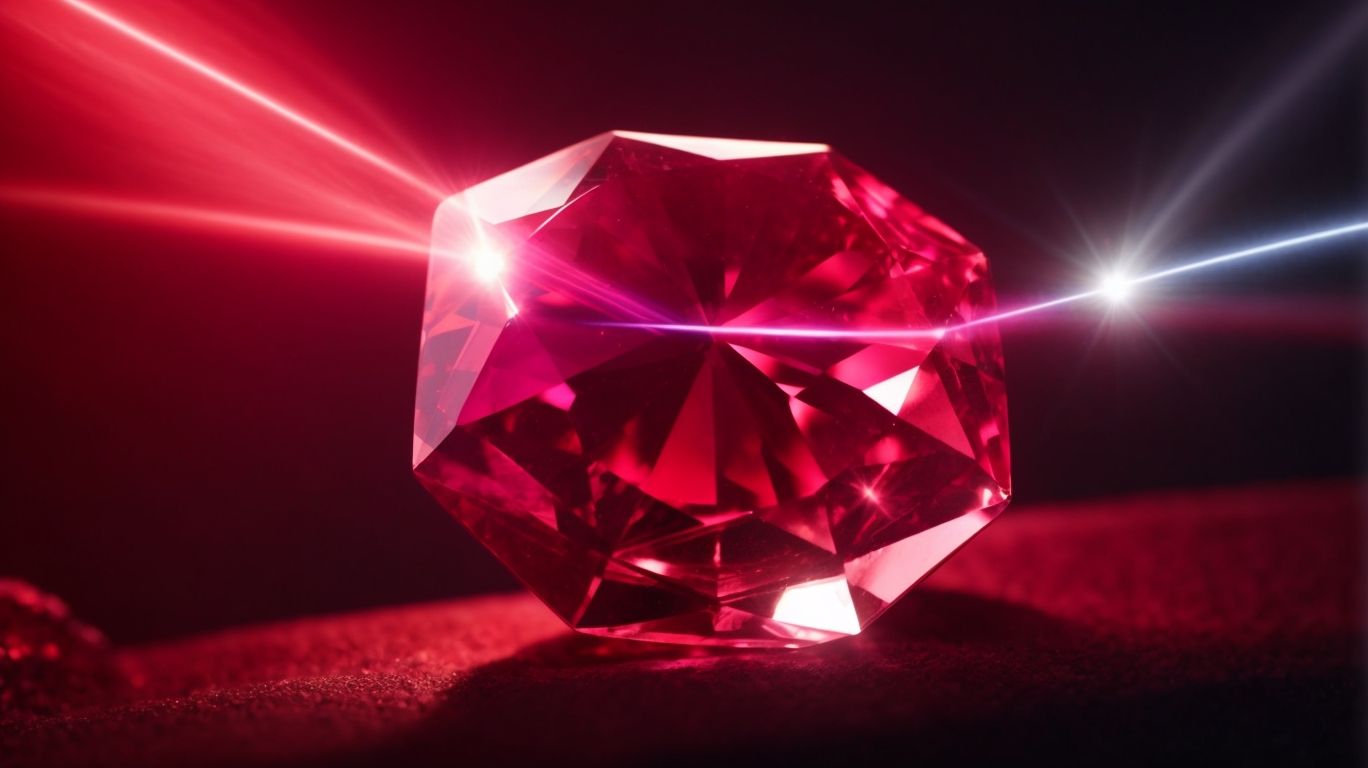
From Laser to Love: The Fascinating Uses of Rubies Throughout History
Rubies have been prized for centuries for their vibrant red hue and symbolic significance. But did you know that these precious gemstones also have a wide range of industrial applications?
We will explore the chemical composition and formation of rubies, delve into the rich history of their use in various cultures, and discover the valuable role they play in both jewelry and industry.
Join us on a journey from laser to love as we uncover the fascinating uses of rubies throughout history.
What are Rubies?
Rubies are precious gemstones known for their rich red color and historical significance in various cultures, symbolizing love, passion, and strength.
Their striking red hue captures the attention of many, making them a popular choice for jewelry such as rings, necklaces, and earrings. Throughout history, rubies have held a special place in ancient civilizations like the Egyptians, who believed that they held protective powers. In the field of gemology, rubies are recognized as one of the four precious gemstones alongside diamonds, sapphires, and emeralds. Due to their rarity and exquisite appearance, rubies are highly prized and sought after by collectors and enthusiasts worldwide.
What is the Chemical Composition of Rubies?
Rubies are primarily composed of corundum, a mineral with a crystal structure that gives these gemstones their exceptional durability and hardness.
Corundum, which is an aluminum oxide, forms in the trigonal crystal system and is often found as large hexagonal-shaped prisms in nature. This unique crystal structure contributes to the toughness and resistance to scratching that rubies are known for. This makes rubies not only beautiful gemstones but also practical for everyday wear in jewelry. Due to their hardness, rubies are also used in various industrial applications such as in high-tech tools and equipment requiring tough and durable components.
How are Rubies Formed?
Rubies are formed under intense geological conditions, often found in regions such as Myanmar, Thailand, Africa, and other locations rich in corundum deposits.
These exquisite gemstones typically originate deep within the Earth’s crust, where high pressure and temperatures contribute to their formation. The presence of aluminium oxide, known as corundum, plays a crucial role in the development of rubies. Regions abundant in corundum, such as Myanmar’s Mogok Valley, the Thai provinces of Chanthaburi and Trat, and various African countries like Mozambique and Tanzania, are prime locations for ruby mining. The geological processes that occur in these areas, including metamorphism and geological activity over millions of years, are key factors in creating the ideal conditions for the growth of these precious gems.
The History of Rubies
The history of rubies dates back to ancient civilizations, where these precious gems were revered for their mystical properties and used in trade, jewelry, and royal regalia.
In various ancient cultures such as those in India, rubies were believed to possess powers that could bring good fortune and protection to the wearers. Rubies were highly coveted in the gemstone trade, with merchants traveling far and wide to acquire these precious gemstones. Legends and myths surrounding rubies often depicted them as stones of passion and courage, further enhancing their allure. Throughout history, rubies have been prominently featured in royal gemstones and crown jewels, symbolizing power, wealth, and prestige for rulers and monarchs.
What Cultures Have Used Rubies?
Various cultures across the world have valued rubies for their symbolic meanings and mystical properties, associating them with the month of July and describing their hue as blood-red.
In many societies, rubies are seen as a representation of love, passion, and strength due to their intense red color. They have been integrated into various belief systems and legends, often symbolizing vitality and protection. In gemstone lore, rubies are believed to possess significant healing energies, enhancing one’s vitality and life force. From ancient civilizations to modern times, rubies have held a special place in folklore and jewelry making, captivating individuals with their allure and timeless beauty.
What Are the Symbolic Meanings of Rubies?
Rubies hold symbolic meanings associated with healing properties, chakra balancing, and energy healing, believed to enhance vitality and promote spiritual well-being.
These precious gemstones have been revered for centuries for their ability to stimulate the heart chakra, promoting love, compassion, and emotional healing. In energy healing practices, rubies are thought to awaken the Kundalini energy, bringing a sense of power and rejuvenation. They are also considered to provide spiritual protection, shielding the wearer from negative energies and instilling a sense of courage and strength.
The vibrant red color of rubies is often linked to passion, life force, and manifestation of desires, making them a potent tool for those seeking to align with their true purpose.
What Are Some Famous Rubies Throughout History?
Several famous rubies have left a mark on history due to their exceptional beauty, historical significance, and admiration by gemstone enthusiasts for their rarity and unique characteristics.
- One of the most renowned rubies is the Sunrise Ruby, a vivid red gem known for its pigeon’s blood color and remarkable clarity. This exceptional stone has captivated many with its mesmerizing glow and perfect cut.
- Another notable ruby is the De Long Star Ruby, famous for its unique asterism effect, creating a striking six-pointed star when exposed to light. These rubies, along with others like the Rosser Reeves Star Ruby, stand as testaments to the enduring allure and fascination that these precious gemstones hold in the world of jewelry and history.
The Uses of Rubies in Jewelry
Rubies are highly valued in jewelry for their vibrant color, durability, and symbolic significance, making them popular choices for engagement rings, anniversary gifts, and other exquisite pieces.
These precious gemstones are often associated with love, passion, and romance, making them a perfect choice for expressing deep emotions on special occasions.
When it comes to customizing jewelry, rubies are favored for their versatility in design options. From classic solitaire settings to intricate halo designs, rubies add a touch of elegance and sophistication to any piece.
The process of cutting and polishing rubies requires precision and expertise to bring out the stone’s natural beauty and brilliance. Skilled craftsmen carefully shape the ruby, enhancing its color and clarity before setting it into the jewelry piece.
What Makes Rubies Valuable in Jewelry?
Rubies are highly prized in jewelry for their exceptional hardness, intense red color, and versatility in jewelry making, contributing to their enduring value and appeal.
Their remarkable hardness, registering 9 on the Mohs scale, ensures durability and longevity, making them ideal for everyday wear. The intense red hue of rubies, known as ‘pigeon blood red,’ adds a bold and vibrant touch to any piece, symbolizing passion and vitality. Jewelers cherish rubies for their suitability in a wide range of jewelry-making techniques, from traditional settings to intricate designs, allowing for creativity and innovation in crafting exquisite pieces. These exceptional characteristics combine to elevate the allure and desirability of rubies in the competitive jewelry market.
What Are Some Popular Cuts and Settings for Rubies?
Popular cuts and settings for rubies include classic styles like solitaire rings, halo settings, and vintage-inspired designs, often chosen for their timeless elegance and appeal as anniversary gifts or statement jewelry pieces.
Solitaire rings are a popular choice for showcasing the beauty of a single radiant ruby, symbolizing love and commitment. On the other hand, halo settings add a touch of glamour by surrounding the ruby with a dazzling array of smaller diamonds or gemstones. Vintage-inspired designs bring a sense of nostalgia and sophistication, making them ideal for those who appreciate the charm of bygone eras. These styles are not only exquisite choices for marking special milestones like anniversaries but also make stunning statement pieces for any occasion.
How Do You Care for Ruby Jewelry?
Caring for ruby jewelry involves gentle cleaning with a soft cloth, avoiding exposure to harsh chemicals, and periodic maintenance to retain the gemstone’s luster and brilliance over time.
To maintain the beauty of your precious ruby jewelry, it’s important to steer clear of harsh chemicals that can damage the gemstone’s surface. Instead, opt for a mixture of mild soap and lukewarm water to gently clean your rubies. Simply soak the pieces in the solution for a few minutes, carefully scrub with a soft brush if needed, and rinse thoroughly. After cleaning, ensure your ruby jewelry is completely dry before storing it. Store your rubies in a fabric-lined jewelry box or individual pouches to prevent scratching and keep them away from direct sunlight to preserve their vibrant color.
The Industrial Uses of Rubies
Rubies find diverse industrial applications, from laser technology for cutting and engraving to medical uses such as laser surgery and sensing technology, showcasing the versatility and value of these gemstones beyond the realm of jewelry.
Their exceptional hardness and thermal conductivity make rubies ideal for use in laser systems, where they are employed as optical components due to their ability to withstand high energy levels. In laser cutting, rubies help produce precise and clean cuts in various materials like metals and ceramics. In engraving applications, rubies enable intricate designs with a high level of accuracy. The use of rubies in medical fields like laser surgery underscores their critical role in minimally invasive procedures, highlighting their significance in advancing healthcare technologies.
What Makes Rubies Useful in Industry?
The optical properties and durability of rubies make them invaluable in various industries, ranging from laser technology to gemstone trade, where their unique characteristics enhance the quality and functionality of different products and processes.
Their ability to efficiently convert energy into laser light makes rubies essential components in laser applications. The red hue of rubies is a result of the element chromium in their composition, which also contributes to their laser-related properties. In the gemstone trade, rubies are prized for their vibrant color and high clarity, adding value to jewelry and ornamental pieces. The durability of rubies ensures that products using them maintain their beauty and luster over time, making them a popular choice for enhancing the overall appeal of items.
What Are Some Examples of Industrial Uses for Rubies?
Industrial uses for rubies include laser technologies for cutting and welding, as well as synthetic rubies employed in optical instruments, watchmaking, and specialized industrial applications, showcasing the diverse practical applications of these gemstones.
In laser technologies, rubies are utilized for their exceptional hardness and ability to withstand high temperatures, making them ideal for cutting and marking various materials such as metals and ceramics. The precise and efficient nature of ruby lasers enables them to be widely used in manufacturing processes like drilling tiny holes in semiconductor chips or welding delicate electronic components. Synthetic rubies find applications in optical instruments like laser resonators and high-end watches due to their optical clarity and durability.
In specialized industrial contexts, rubies serve as crucial components in laser systems for medical procedures, ranging from eye surgeries to dermatological treatments.
How Are Synthetic Rubies Used in Industry?
Synthetic rubies are utilized in various industries for technological advancements, contributing to sectors such as laser technology, watchmaking, and the gemstone market, where their quality and consistency play a crucial role in meeting industry demands.
These lab-created gems have become integral to the field of laser technology, where their high hardness and thermal conductivity make them ideal components in laser systems for cutting and engraving various materials with precision. In the domain of watchmaking, synthetic rubies are widely used as jewel bearings due to their durability, smooth surface finish, and resistance to wear, ensuring the efficient functioning of mechanical timepieces. In the gemstone market, their availability in different sizes and shapes provides industries with options that meet specific design requirements.




No Comments